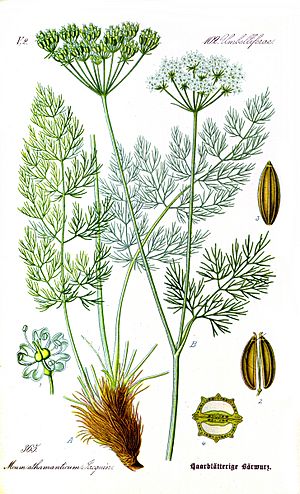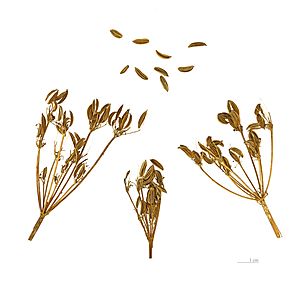Meum facts for kids
Quick facts for kids Meum |
|
|---|---|
 |
|
| Scientific classification | |
| Genus: |
Meum
|
| Species: |
athamanticum
|
Meum athamanticum is a special kind of plant. It's the only species in its group, called Meum. This plant is known for its strong, pleasant smell. It's a perennial plant, which means it lives for more than two years. In the UK, people call it baldmoney, meu, or spignel.
Contents
Where Meum Grows
This plant loves grassland areas, especially where there's limestone rock. You can often find it in mountain regions across Western Europe and Central Europe. It grows as far south as the Sierra Nevada (Spain) mountains and in Bulgaria.
In the UK, it's not very common. You might find it in a few places in Northern England and Northern Wales. It's a bit more common in Scotland, growing as far north as Argyll and Aberdeenshire.
Uses of Meum Athamanticum
People have used Meum athamanticum for a long time.
Meum as Food
In Scotland, people used to grow this plant. They would eat its roots, much like other root vegetables. The delicate, feathery leaves can also be used to add flavor to food.
Traditional Remedies
The plant has also been used in traditional home remedies. For example, it was used to help the body get rid of extra water (as a diuretic). It was also used for stomach problems.
The roots of Meum smell a lot like other plants used in cooking and medicine, such as Levisticum officinale and Angelica archangelica. The leaves of Meum have a special smell, a bit like fresh hay. This smell can even get into milk and butter if cows eat the plant in spring.
Interesting Names
The unusual name Baldmoney is thought to come from the name of the god Baldr from Scandinavian mythology. People believed the plant was special to him.
In German, the plant is called Bärwurz, which means "bear wort." There's also a type of Bavarian schnapps (a strong alcoholic drink) that gets its flavor from this plant.
See also
 In Spanish: Meum athamanticum para niños
In Spanish: Meum athamanticum para niños


